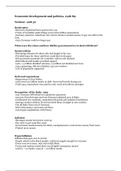Economic development and policies, 1918-89
Weimar, 1918-32
Bankruptcy
-Reserves of gold had been spent in the war
-Treaty of Versailles made things worse (£6.6 billion reparations)
-Germany asked for reductions, but victors (France) needed money to pay war debt to the
USA.
-1923, Germany could no longer pay
What were the crises and how did the government try to deal with them?
Social welfare
-Retraining schemes for those who had fought in the war
-Provided loans for those until they could find work again
-Set up pension payments for wounded, widows and orphans
-Both federal and Lander provided support
-1920, 1.5 million disabled veterans, 1.9 million not disabled survivors
-1924 supporting 768,000 disabled, 420,000 widows
-10% of population supported
Debt and reparations
-Reparations of £6.6 billion
-1918 owed 150 million marks in debt- borrowed heavily during war
-Until 1924, reparations were paid in coal, wood and railway carriages
Occupation of the Ruhr, 1923
-1921 Germany fell behind on reparations payments
-750,000 French troops sent into German industrial area of Ruhr.
-Confiscated raw materials, manufactured goods and industrial machinery
-German workers striked, French arrested them, brought in own workers
-Cut off Ruhr from rest of Germany
-80% of Germany’s steel and coal there
-1923 began negotiations with France
Inflation
-Shortages meant food prices went up
-Pay more to get want they want
-Government needed money for debts, unemployment, received less money from taxes.
-Printed more money
Hyperinflation
Inflation that goes out of control
-People relied on the black market, could not supply enough for everyone
-Prices rose even more, only rich could afford
-Towns and regions issued their own Notgeld ‘emergency money’
-1918 £1 = 20 marks, 1923 £1 = 20 billion marks





